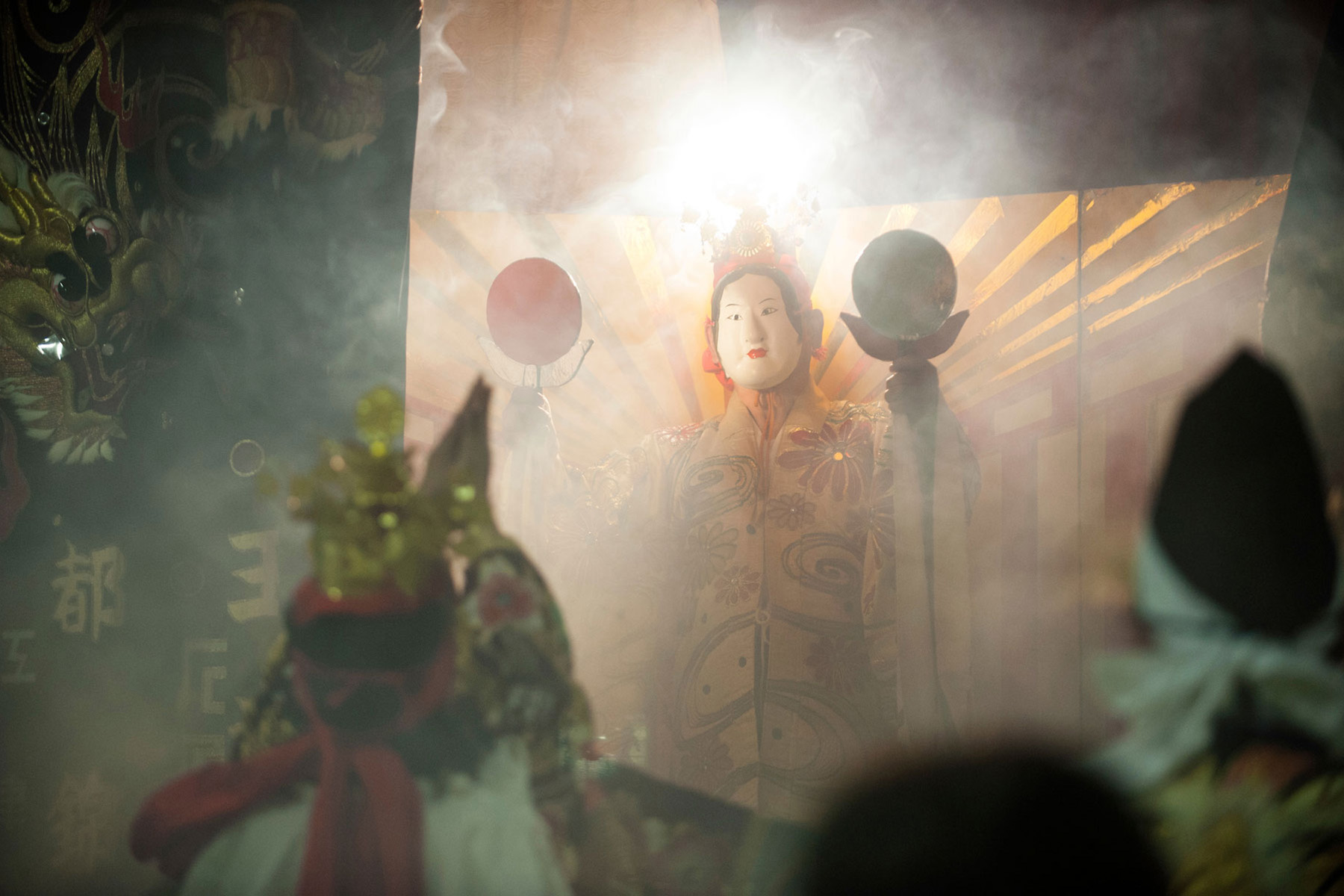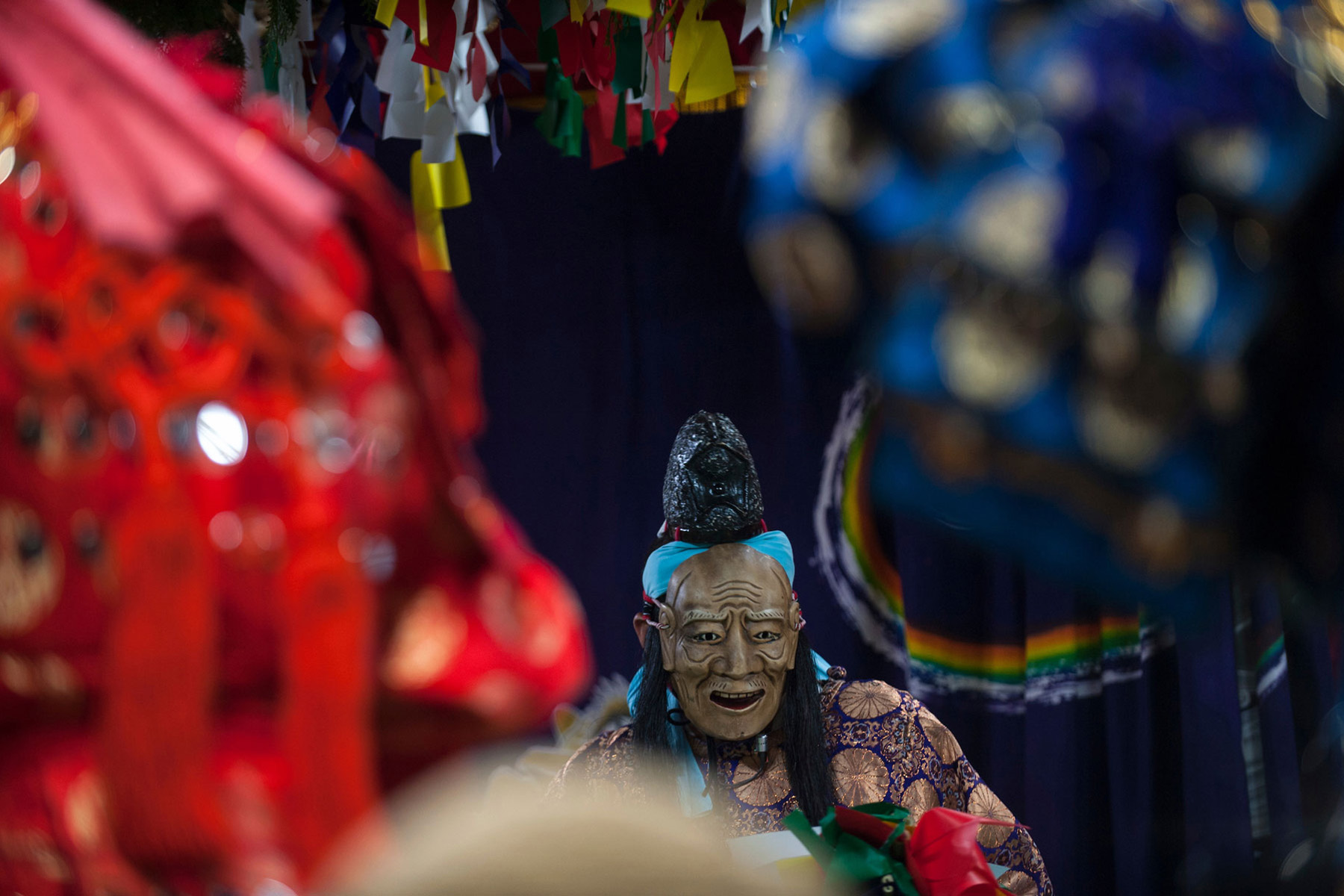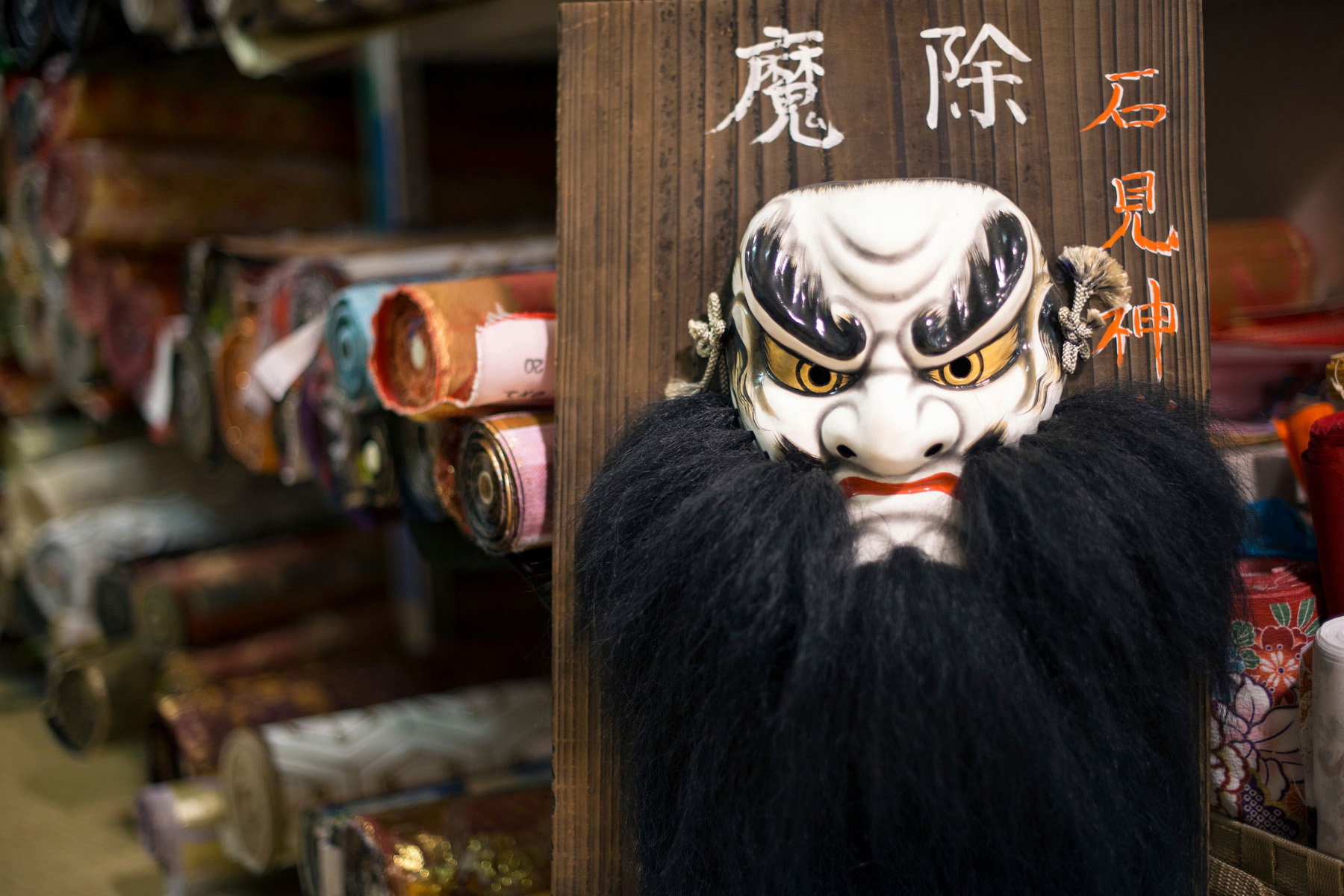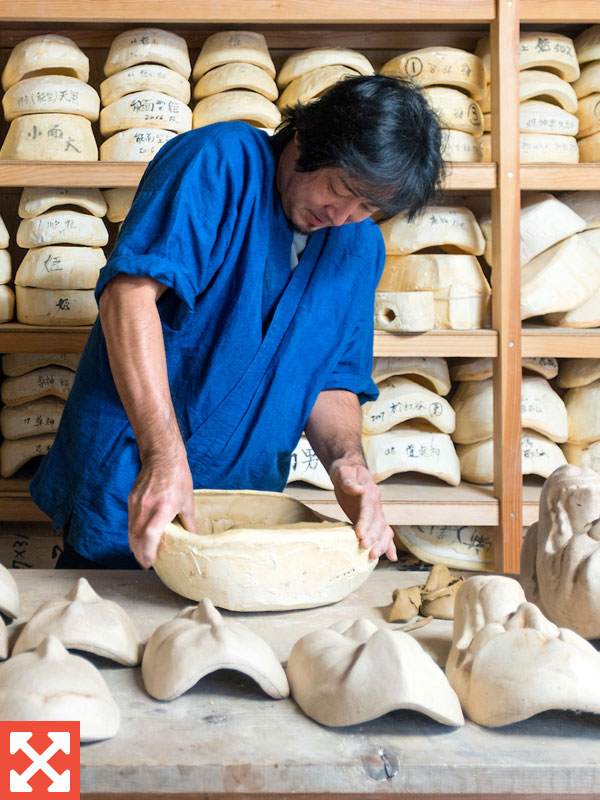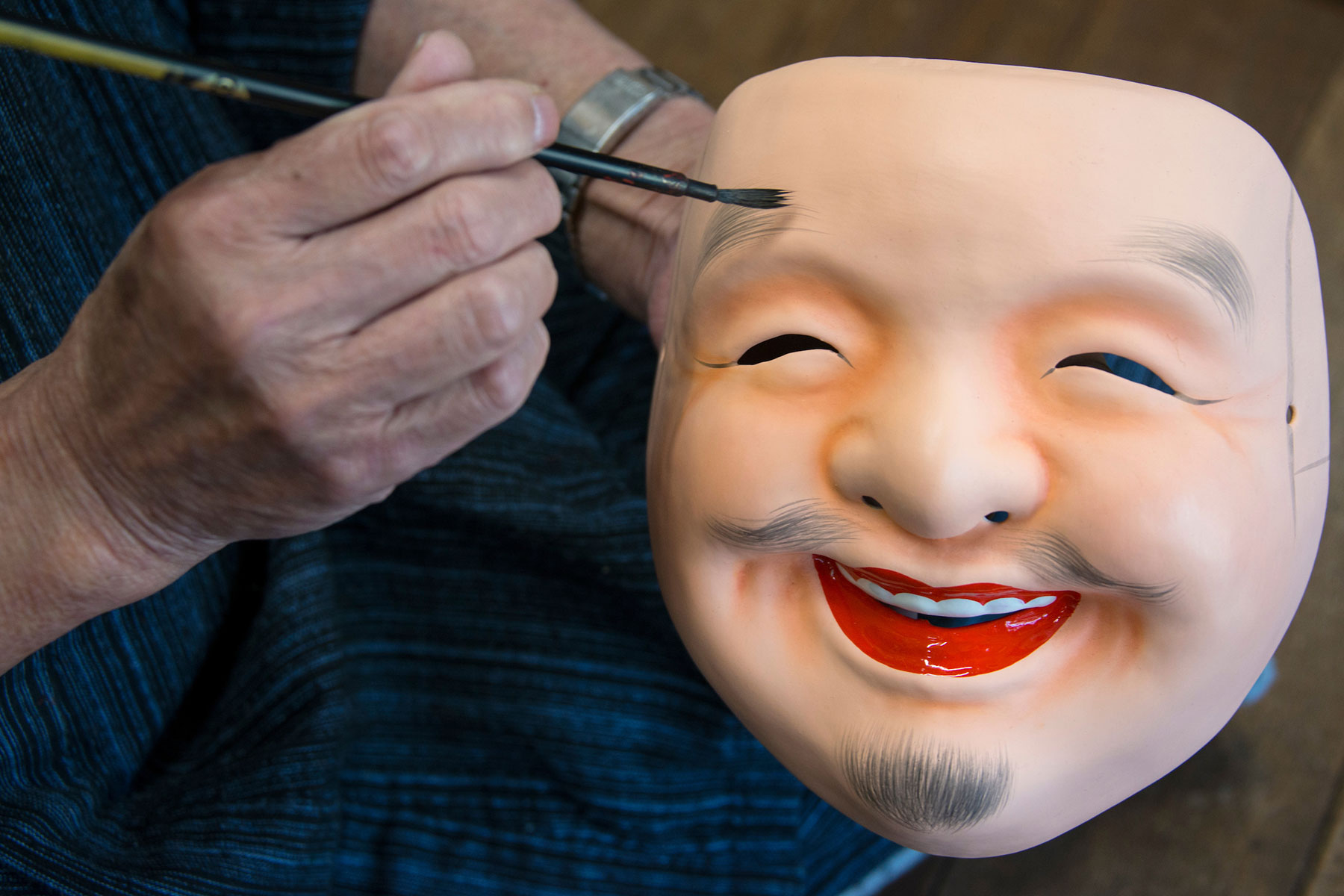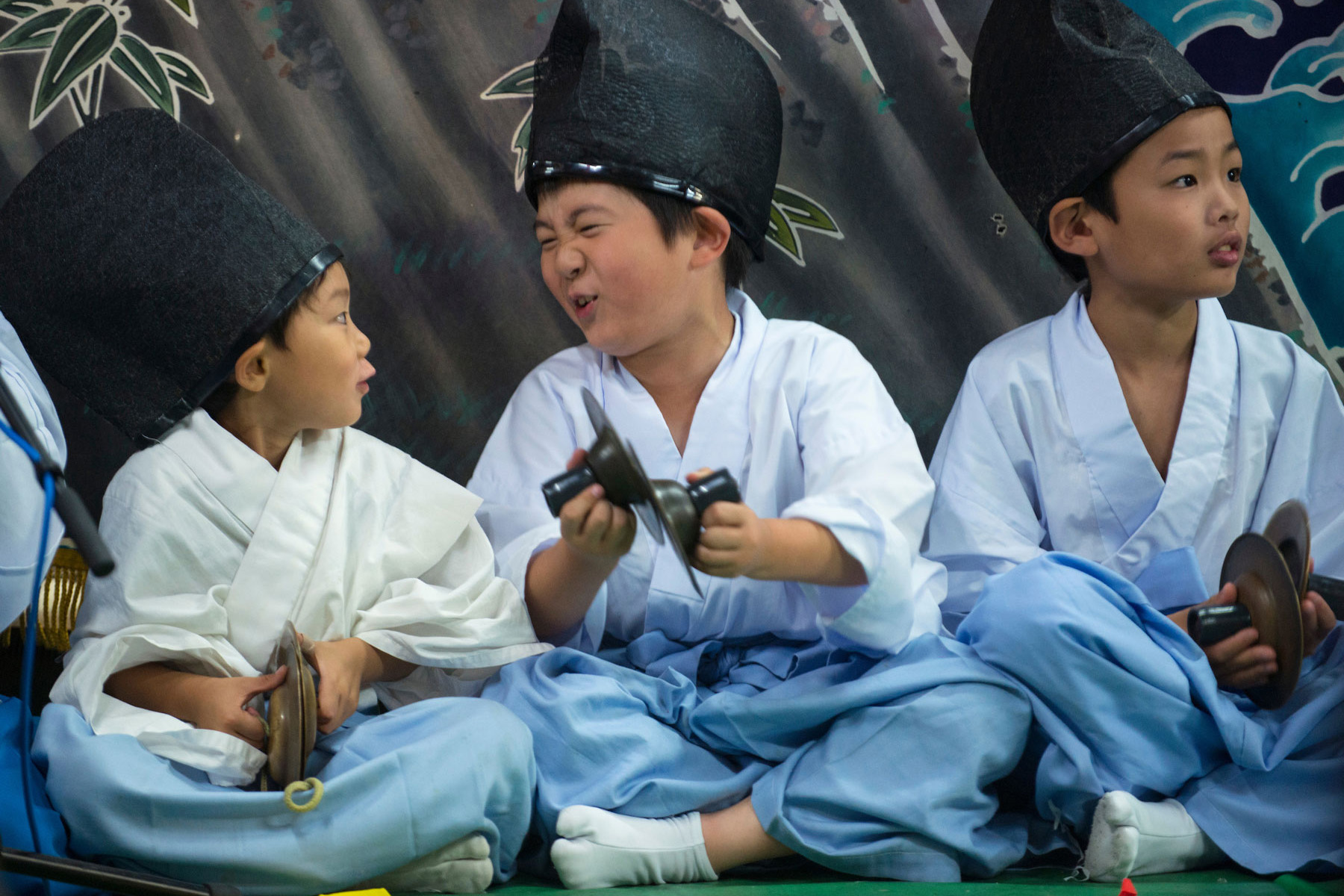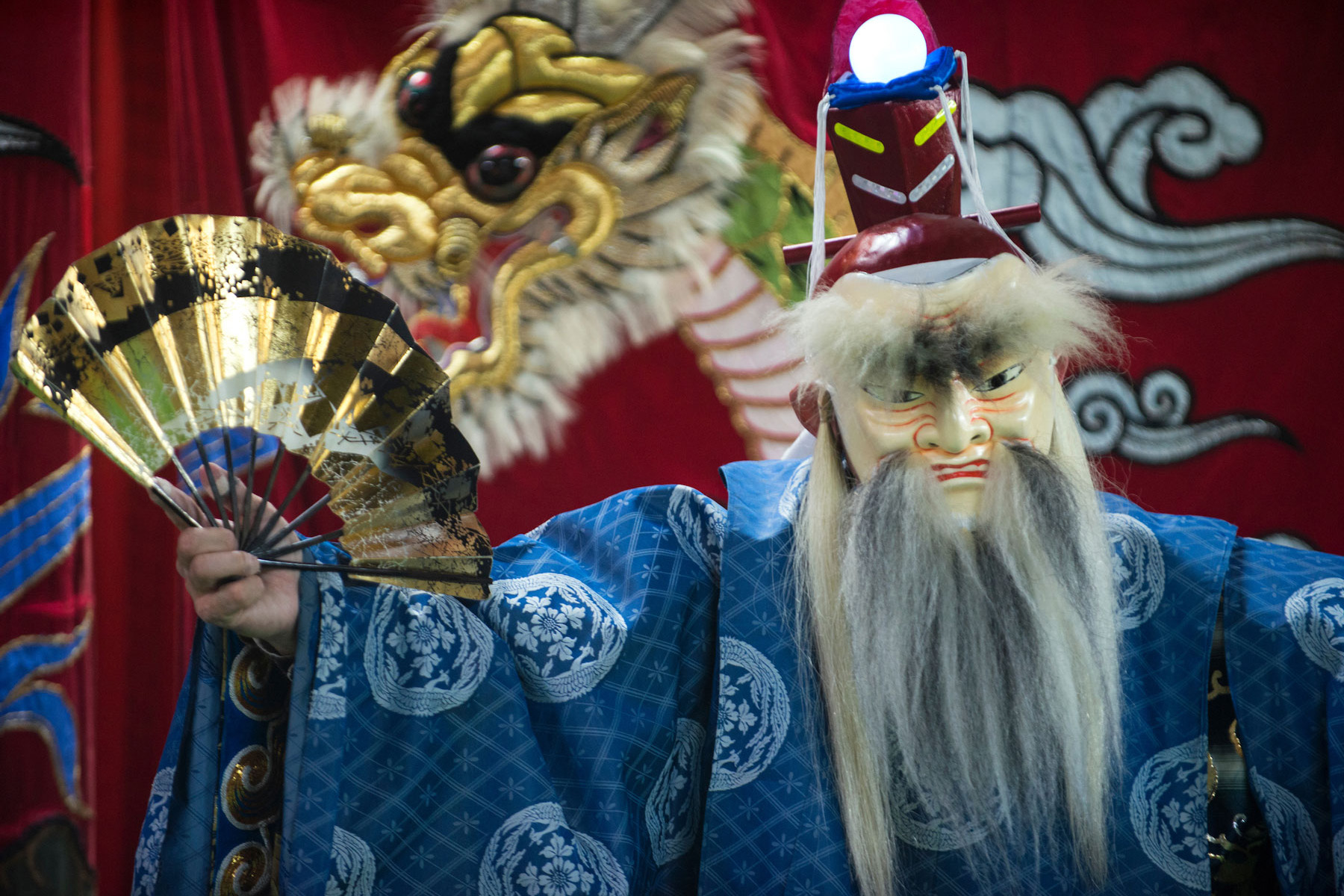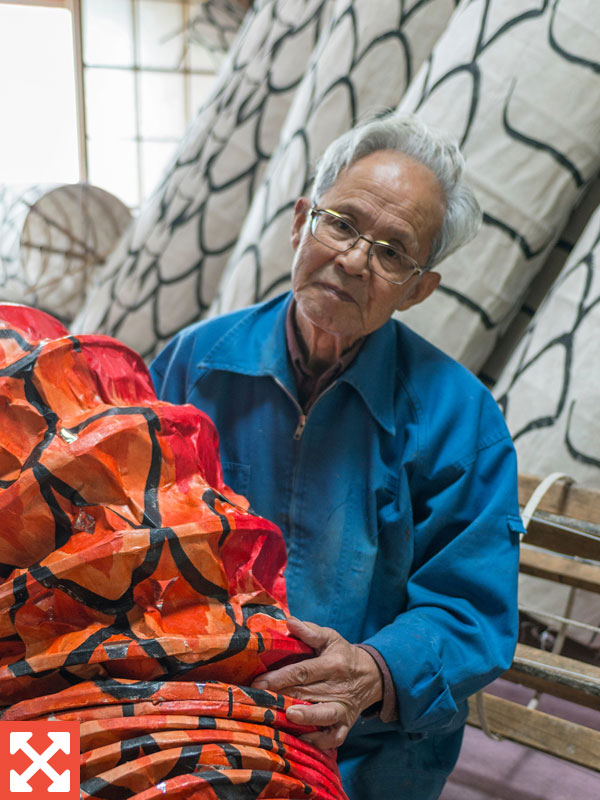CULTURE
Iwami-kagura: The changing face of a Shimane theatrical tradition
Masks made by Katsuro Kakita and his son, Kenji, in Hamada, Shimane Prefecture. ROB GILHOOLY
Taking an in-depth look at the meticulous work that goes into the lavish costumes and masks worn by Iwami-kagura troupes
ROB GILHOOLY
Contributing writer
Kneeling on the floor of his atelier in the Nagahama district of Hamada, Shimane Prefecture, master craftsman Katsuro Kakita applies the finishing touches to one of his colorful, striking and sometimes terrifying creations.
Each depicts characters from Japanese mythology, such as the jealous female demon Hannya, the two-horned, fang-toothed creature, Oni, or the grinning god of good fortune, Ebisu.
Today, however, the object of Kakita’s artistic flourishes is Yamata no Orochi, a green-faced, red-eyed dragon-serpent that appears in one of the most spectacular performances of the Iwami-kagura theatrical tradition.
“I never see what we create here as being truly complete,” says Kakita, who, along with his son, Kenji, makes the enthralling masks used in Iwami-kagura dances. “That only happens when kagura actors put them on and perform. That’s when they come to life.”
In these parts, that’s a pretty regular occurrence, with kagura performances taking center stage at hundreds of shrines, halls, schools — even a fisheries association’s offices — throughout the region.
They are easy to locate due to the music that accompanies them, characterized by the meandering melodies of yokobue bamboo flutes and hichiriki oboe that are punctuated by chochigane finger cymbals and the pulsating beats of taiko drums.
In the Sano district of Hamada, these sounds can be heard from afar as they cascade down a narrow valley, whose tree-lined slopes loom out of the dark beneath a star-splashed sky.
Their source is found up a steep flight of sunken stone steps, where, inside the cramped, dimly lit Yahata Hachimangu mountain shrine, a cacophony of animated strains punctuates a skillfully choreographed battle between Yamata no Orochi and Susano’o.
The latter, a fearless, fleet-footed deity and hero in Japanese mythology, is tasked with saving Princess Inada, but first has the unenviable task of overcoming Yamata no Orochi, a fire-spewing demon with eight heads, eight tails and a body long enough to span eight peaks and valleys.
To spice things up a bit, Yamata no Orochi has brought along a few of his fiery mates and, as the music rises to a crescendo, Japan’s very own Hercules escapes the dragons’ smothering coils and, with graceful swings of his sword, severs their heads one by one amid billowing smoke.
The play, “Orochi,” is the piece de resistance of kagura, a genre of dance and music that is considered to be the earliest Japanese performing art.
It’s so old, in fact, that according to legend it was first performed to amuse the gods — hence the direct translation of kagura: “god entertainment.”
The mythical roots of kagura performances are recounted in Japan’s earliest extant chronicle, the eighth-century “Kojiki.” There the tale of Ame no Uzume — the goddess credited with introducing revelry to the world — performs an amusing dance to lure the reclusive sun goddess Amaterasu out of her cave and bring light and warmth to the world.
In more terrestrial parts, many types of kagura have evolved, most incorporating scenes from Shinto mythology and other historical or fabled themes. The most traditional forms are ritualistic, such as the mikagura dances still performed at the imperial court and other sacred places by miko shrine maidens — attendants, it is claimed, who are descended from Ame no Uzume. Others are highly theatrical. Known under the umbrella term “sato kagura” (“village kagura”), this latter style was officially encouraged during the Meiji Era (1868-1912) in an attempt, some kagura experts say, to suppress quasi-shamanistic versions that had spread throughout more remote parts, and which can still be seen today.
Others are highly theatrical, coming close to kabuki. Known under the umbrella term “sato kagura” (“village kagura”), this latter style was officially encouraged during the Meiji Era (1868-1912) in an attempt, some kagura experts say, to suppress quasi-shamanistic versions that had spread throughout more remote parts, and which can still be seen today.
Subsequently, residents began to assume the roles that had traditionally been played by shrine priests and attendants, who were previously the sole purveyors of ritualized plays sometimes referred to as shinshoku kagura (priest kagura), but were officially prohibited from participating following the Meiji edict.
This genre flourished, and today an estimated 350 kagura troupes perform throughout the region and, indeed, across Japan, many maintaining ties with shrines in their locality.
Arguably the most popular variety can be found in the Iwami-kagura tradition, which is performed by some 145 troupes in a part of western Shimane Prefecture once known as Iwami, whose capital was Hamada during the Heian Period (794-1185). In the nearby city of Oda, there is even a centuries-old troupe made up entirely of children.
During the annual autumn festival, hundreds of kagura performances take place in Hamada, Oda and other towns and villages throughout the region.
Traditionally programs start in the evening and continue well into the following morning. Earlier plays mix more orthodox, ritualized and downtempo sketches to welcome the deities. There are also comedic ones primarily for children — the story of the portly, jovial Ebisu and his humorous attempts to land a carp while casting fistfuls of candy bait being a particular favorite.
As the evening wears on, some performances can give way to bawdy, alcohol-fueled pantomime where no member of the audience is safe from being dragged onstage to join the revelries, many egged on to down a bowl of sake.
“Perhaps because of its roots, kagura can give the impression of being rather austere, but that’s not always the case in these parts,” says local resident Iwao Fujita as he watches another humorous play depicting the brave 12th-century poet and warrior Minamoto-no-Yorimasa, and his dog, Ino-hayata, defeating Nue, a monster with a monkey’s head, a tiger’s feet, an ox’s torso and a serpent’s tail. “If the gods wanted to be entertained that probably means they also wanted to laugh and enjoy themselves as well.”
Children watch a kagura performance at Hachimangu Shrine in Hamada, Shimane Prefecture, in October 2017. ROB GILHOOLY
Time-honored standards remain at the core of many shows, but over the past 150 years the Iwami-kagura repertoire has increased more than threefold to some 100 plays, according to Takashi Shimono, a member of the Mikawa Nishi Kagura Hozonkai, a troupe made up of doctors, factory workers, fishermen and public officials that is devoted to the protection of Iwami-kagura, performing both domestically and overseas.
While the underlying deity-pacifying objective remains and the musical accompaniment continues to play a crucial additional diversion, many present-day plays are characterized by their pulsating tempo, called hacchoshi (eight-beat), and an increasingly elaborate array of costumes, masks and other engaging contrivances.
The masks, which are known as kagura-men, have undergone a few modifications over the years, the most important of which was a direct result of the pacy hacchoshi performances, which can leave dancers breathless and drenched in sweat.
Formerly sculpted from wood, kagura-men were weighty and inflexible, making them cumbersome — not to mention suffocating — for performers, who sometimes switch masks and costumes during performances. They were also difficult to maintain, encouraging craftsmen to look at alternative materials to address these issues.
They found the answer in a familiar source — a hardwearing tesuki washi (handmade paper) known as Sekishu-banshi that has been produced in Iwami for more than 1,300 years and was listed on UNESCO’s intangible cultural heritage list in 2014.
“Iwami-kagura costumes can weigh up to 60 kilograms and, because the movement in (hacchoshi) performances is fast and energy-sapping, we have to create masks that are light, but durable at the same time,” Kakita says.
At Kakita’s workshop, making the colorful and sometimes ghoulish masks, which add a spectacular, outlandish element to the shows, is a painstaking papier mache-like process, starting with Katsuro’s son, Kenji, creating clay bases from hand-carved molds. These are then dried and covered with layer upon layer of Sekishu-banshi, each applied using an adhesive made from persimmon tannin, which has insect-repelling, waterproofing and other preservative properties, Kenji explains, adding that Sekishu is another historical name for Iwami.
Once completely dried, the mould is smashed and the mask surface painted with multiple layers of a paste made from ground seashells and horse hoof glue.
Holes for the eyes, nose and hair are made by searing red-hot poker-like rods through the masks, which Kenji then sands down to a silky-smooth surface onto which his father adds various decorative materials, including pigments, gold leaf, charcoal for subtle shading, varnish and hair.
To keep up with new adaptations of the plays, the Kakitas and other mask makers frequently come up with new, even more fantastical creations for Iwami-kagura troupes in Shimane and dozens more performing in parts of neighboring Hiroshima Prefecture. Most famous is a fire cracker-like device hidden inside Orochi’s mouth that allows the dragon-serpent to “breathe” plumes of smoke and fire-like sparks.
“We have also come up with a system whereby multiple characters can be incorporated in one mask,” Kenji explains as he serves a customer who has traveled from Hiroshima to collect an order for his kagura troupe.
The masks are hugely symbolic in the region and not limited to use in kagura performances. Customarily, local residents have presented them as housewarming and other celebratory gifts. They are also employed as gargoyles to ward off evil spirits and can be found hanging outside homes and in a number of public locations, including railway and service stations.
The Nagahama district has a craft-making tradition dating back almost 1,000 years, Kakita says. The best known of them are terracotta dolls, which he says as a child he remembers seeing being made by dozens of craftsmen, who also made kagura masks as a side business. This made such an impression on Kakita as a child that he decided to teach himself how to make the masks. Today, he is one of just a handful of craftsmen in the area who continue that tradition.
Even fewer in number are those making another decorative device commonly seen in Iwami-kagura performances.
A short drive away from the Kakitas’ atelier, Rinkichi Ueda constructs 17-meter-long jado serpent-dragons, which are a vital feature of plays such as “Orochi.”
Ueda, 86, explains that it was his grandfather, Kikuichi, who invented jado (literally “snake torso”) for the dances over a century ago, inspired, he says, by traditional paper lanterns.
“Until the Meiji Era, the creatures were represented by little more than a serpent-like headdress and white clothing onto which scales were drawn,” says Ueda, 86. “These lacked charm and realism.”
To form the frame of the jado, Ueda bends lengths of bamboo into hoops of about 1 meter in diameter — a total of 99 of them that are spread out at roughly 17-centimeter intervals.
With assistance from his wife, Tokue, he then pastes three layers of Sekishu-banshi paper over the top to form a 17-meter-long concertina-like structure before painting the striking designs on top.
Like the Kakitas, Ueda, has also modified his creations over the years, developing paints from pigments that are more permanent and durable. And as troupes have increased the number of jado used in an attempt to increase the dynamism of performances, Ueda has added subtle color variations to make his inventions even more arresting.
Ueda says he’s often asked why Iwami-kagura is thought of as the real deal when legends such as “Orochi” actually originated in another region of Shimane, called Izumo — home to one of Japan’s most ancient and important shrines, Izumo-taisha.
“I think the answer’s in the jado and the dynamism they add to the performances,” he says. “They have become a representative and indispensable feature of Iwami-kagura.”
So, too, the garments, each of which is meticulously hand-stitched to ensure authenticity, says Kyoji Goto, who has been making the resplendent kagura costumes for almost 20 years.
“Until around the Meiji Era, costumes were produced by dyeing fabric, but became increasingly gorgeous thereafter,” says Goto, whose atelier in Hamada produces more than 20 costumes a year.
Many of the outfits take months to produce, some carrying a price tag of up to ¥2 million, he says.
“In the past, there was a finite number of characters represented in kagura and, therefore, only a finite number of costumes required. In recent years, however, troupes request unique designs that reflect their identity,” says Goto, who works alongside a local welfare group providing employment for people with disabilities, who he also helps to train. “This, plus ensuring durability, are the two biggest tests of (a craftsman’s) skill.”
In addition to making the clothing, Goto has also been part of a Hamada kagura troupe for more than 40 years.
“Kagura is my life, but you’ll find many people in these parts love and know their kagura,” he says. “Without that, such traditions would not continue to thrive. Despite the issues of aging and depopulating communities, there are still young people wanting to continue traditions such as kagura.”
Mask maker Kakita agrees, saying that local troupes made up of young members — including the Tsuchie children’s kagura group in Oda — are making increasing efforts to introduce the tradition throughout Japan and even overseas.
In addition to the obligatory baseball, soccer and other clubs, the local technical high school also has a kagura club, probably the only one in Japan, he says.
“That’s a huge characteristic of Iwami-kagura,” he says. “In many places, it’s the younger people who are not just keeping the tradition alive, but also driving it forward.”
Among them is Miyuki Oya, 24, who is one of an increasing number of women performing in what has traditionally been a male-dominant art form.
“Kagura has captivated me from when I was a child,” Oya says during a kagura all-nighter at Tashiro Shrine in Hamada, where she was performing as a member of Nishimura troupe. “I used to dress up in my grandma’s kimono and dance about, mimicking the plays and when I was a little older I’d sneak off as far as Hiroshima to watch performances there. There’s something irresistible about kagura. Just thinking about it gives me goose bumps.”
According to Hitoshi Hidaka, the Nishimura troupe’s leader, this is a feeling instilled deep in the psyche of all people in the region.
“When children hear the sound of the bamboo flute and drums, their heads turn instinctively," he says, adding that, like Oya, many also mimic the dances. “Kagura is in our DNA.”



